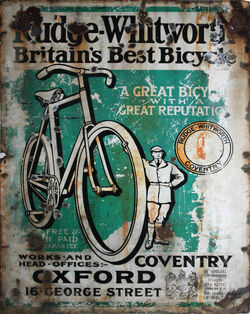 | |
| Predecessor | Rudge Cycle Co, Whitworth Cycle Co |
|---|---|
| Founded | 1894 merger of predecessors |
| Founder(s) | Daniel Rudge, Charles H Pugh |
| Defunct | 1939 |
| Headquarters | Coventry & Birmingham, United Kingdom |
| Key people | C H, C V and John Pugh |
| Products | Bicycles, motorcycles, wheels |
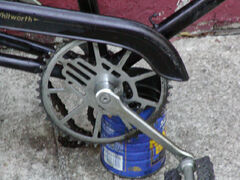
Bicycle chainring with the Rudge-Whitworth hand logo on it
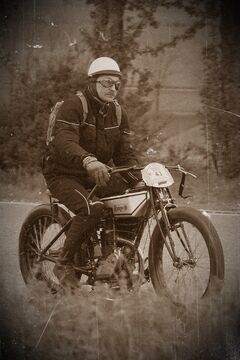
Rudge Multi from 1914

A poster for Rudge-Whitworth wire wheels and their prize for the 1923 24 Hours of Le Mans
Rudge Whitworth Cycles was a British bicycle, bicycle saddle,[1] motorcycle and sports car wheel manufacturer that resulted from the merger of two bicycle manufacturers in 1894, Whitworth Cycle Co of Birmingham, founded by Charles Henry Pugh (1840-1901) and his two sons Charles Vernon and John,[2] and the Rudge Cycle Co of Coventry (which descended from a bicycle company founded by Daniel Rudge of Wolverhampton).
Rudge motorcycles were produced from 1911 to 1946. The firm was known for its innovations in engine and transmission design, and its racing successes. Their sales motto was "Rudge it, do not trudge it."
The company also produced the first detachable wire wheel in 1907,[3] and was known for its knockoff wheels on sports cars well into the 1960s.
Motorcycles[]
Rudge Multigear[]
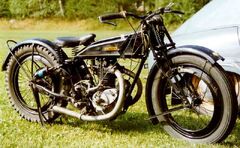
Rudge 500 cc TV 1927
Selling re-badged Werners in 1909, the company went on to produce their first motorcycle in 1911, a single-cylinder F-head (IOE - inlet over exhaust), 500 cc bike. In 1912 the belt drive 499 cc Rudge Multigear was released, using variable groove-depth pulleys to gain 21 forward gear ratios, and a top gear as high as 2.75:1. (The Zenith Gradua and 1907 FN 244 cc single used a similar system.) In 1913 a 750 cc Multigear was released. In 1914 Cyril Pullin won the Isle of Man TT on a Rudge Multigear. Together with the Zenith-Gradua this was one of the first continuously variable transmissions (CVT).
In 1915 a 1000 cc using a Jardine four-speed gearbox was released, followed by a 1000 cc Multigear. In 1923, they introduced an in-house manufactured 4-speed gear box to replace the Jardine gearbox, and Multigear production ended.
Rudge Four[]
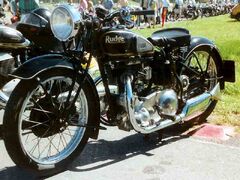
Rudge
It was called a Rudge Four, because of the four speeds and four valves, not four cylinders. This single-cylinder 350 cc machine showed markedly superior performance to the competition on release, having more power than its 500 cc predecessor. Rudge engineer, George Hack, is said to have taken his design idea from the four-valve head Ricardo-Triumph Special of 1921, a one-off machine. He designed a four-valve head for Rudge[4] and in 1924 they produced their first four-valve cylinder head on a 350 cc engine. The valves were arranged in parallel, and were not radial.
In 1925, a 500 cc version with linked front and rear brakes appeared, and the big end bearings were now fed oil through the crankshaft pin. The old 350 cc was dropped in 1926. For 1928 Rudge motorcycles were fitted with saddle tanks, and 8-inch internal expanding drum brakes. Stanley Glanfield designed a Rudge for dirt racing, marketed from 1928 as the Glanfield Rudge.[5]
Racing[]
Ulster Grand Prix[]

Rudge Ulster 500 cc Racer 1936
In 1929 Graham Walker won the Ulster Grand Prix averaging over 80 mph. This prompted the release of the Rudge Ulster, as well as a JAP-engined 250 cc and parallel 4-valve 350 cc. The Ulster was one of their most famous models.
1930s Isle of Man TT victories[]
Rudge bikes finished first, second and third at the 1930 Junior TT using prototype radial 350 cc 4-valve engines. They also took first and second in the Senior TT. The road bike engines were changed to dry sump lubrication. The JAP 250 and the parallel four-valve 350 cc ended production in this year.
In 1931 Rudge released its first 250 cc and 350 cc road machines with the radial-valve layout. TT Replicas were available in 350 cc and 500 cc. The parallel-valve 500 cc was also available in Special and Ulster models, the Ulster now having a 100 mph guarantee. First and second were taken in the 1931 Lightweight TT, and in 1932, second and third.
A radial-head 500 cc was produced for 1932 only. A 250 cc TT Replica was built, and the road bikes were fitted with proper oil bath primary chains, and a stand that could be operated “with just one finger”.[6]
Rudge Cyclecar[]
Between 1912 and 1913 the company entered the booming cyclecar market. Their car used the multigear transmission and a 750 cc single cylinder engine driving the rear wheels via a belt. The two seat bodies had the seats staggered to fit in the narrow body.[7]
Decline[]

Rudge, 500 cc of 1938
With the depression biting, 1933 was the last year of production for dirt-track bikes, and the TT Replicas. The Ulster 500 cc was fitted with a "semi-radial" (parallel valves with radial ports) cast-iron head. For 1934 the Ulster had its head cast in aluminium bronze, and a radial four-valve 250 cc Sports was released. Rudge motorcycles took the first three places in the 1934 Lightweight TT.
A two-valve 250 cc was produced in 1935, and in 1936 the last of the radial four-valve 250 cc model were produced, while round-tube forks were introduced on other models. In 1937 the valve gear became fully enclosed on the 500 cc models, but finances were bad and Rudge was bought by EMI, and production was interrupted, being moved to Hayes, Hillingdon in Middlesex.
A 250 cc two-valve Sports was released in 1938, and for early 1939 the Ulster had an RR50 aluminium cylinder head.[8] Production ceased in December 1939, to convert to radar production for the war effort.
References[]
- ↑ Rudge Whitworth.
- ↑ Hugh Driver, The Birth of Military Aviation: Britain, 1903-1914 Royal Historical Society, Boydell Press, Suffolk UK, Rochester NY, 1997, page 14. ISBN 978-0-86193-234-4
- ↑ Georgano, G.N. Cars: Early and Vintage, 1886–1930. (London: Grange-Universal, 1985)
- ↑ [1] George Hack (retrieved 11 October 2006)
- ↑ The early strutted Rudges did not enjoy much success. However, as the dirt track surfaces became slicker the Rudge came into its own, and by the end of 1930 it ruled the roost. Its success was short lived it would be ousted, in turn, by the speedway JAP.[2] Local Sponend History (retrieved 11 October 2006)
- ↑ [3] The Rudge Enthusiasts Club (retrieved 11 October 2006)
- ↑ Georgano, N. (2000). Beaulieu Encyclopedia of the Automobile. London: HMSO. ISBN 1-57958-293-1.
- ↑ [4] The Rudge Enthusiasts Club Rudge Model Range (retrieved 11 October 2006)
External links[]
- Rudge precis
- Multi Transmission
- Rudge Golden Years
- 1914 Multi TT
- Rudge Enthusiasts Club
- Rudge TT Results
Template:TI Group
| ||||||||
| This page uses some content from Wikipedia. The original article was at Rudge-Whitworth. The list of authors can be seen in the page history. As with Tractor & Construction Plant Wiki, the text of Wikipedia is available under the Creative Commons by Attribution License and/or GNU Free Documentation License. Please check page history for when the original article was copied to Wikia |